Books
Books
published in 2024

poussière de seum
“the following text was written in July 2024 in St Imier, Switzerland.
it's a fragment of Lettres à Bébé, a book I've been writing for some time in which I - Ethan - find myself helping and communicating by letter with a Marxist Baby whose political project is not to grow up so as not to become a tool of Capital. While he develops his project and tells it to me, I live my life and tell it too, observing and commenting on the ignoble state of the world, its language, its architecture, managing my heartbeat, meeting people, working, fucking, eating (...)”. - Ethan Assouline
Published by La Dépendance, St imier (2024)

Sketchbook 1-10
“Sketchbook 1-10” with Antoinette d’Ansembourg bundles a complete collection of pocket sketches created between 2020 and 2023, stretched across ten different notebooks. These sketches, despite their two-dimensionality, form the mainstay of her sculptural output, offering a glimpse into the intimate process behind her stately installations.

Flower Engine
the second poetry collection from Natalie Briggs titled ‘FLOWER ENGINE’. This collection of cinched, bright free-verse explores the passing locations of love and the slow, private operations of pain’s knocking counterweight. The book extends Briggs’ relay of concise universal suggestions, translating them through brief, intimate utility.

CLOUDS
Clouds are, narratively speaking, some tricky things. They are both full and empty. They are vacant and shifting, a site of tension between the material and the immaterial, the perceptible and the invisible. Clouds is also the title of German artist Esther Kläs’ first monograph, which spans over 15 years of sculptures, drawings, and performances. As an organic rendering of a complex practice, this book mirrors both the formal impact of each artwork and the conceptual outreach of a collection of gestures, attitudes, movements, and moods happening around the works. Because Esther’s practice has no tight borders or hard edges. Each piece escapes definition and breaks loose from the patterning power of language. Still, regardless of the medium, everything Kläs does seems to have a common denominator: it is a reiteration of a way of thinking – her way of thinking – through a body in space – her body, as well as a social body.
With four commissioned contributions (Marc Navarro with Ester Partegàs, Julie Boukobza, Chloe Chignell, and Francesco Pedraglio) and six short, loose texts edited by Elena Tavecchia and Kläs herself, the book is a canvas whose patterns shift following the artist’s elaborated work. What stays hovering in the air are sparks of decisions, constant movements, recurrent repetitions, and propositions.
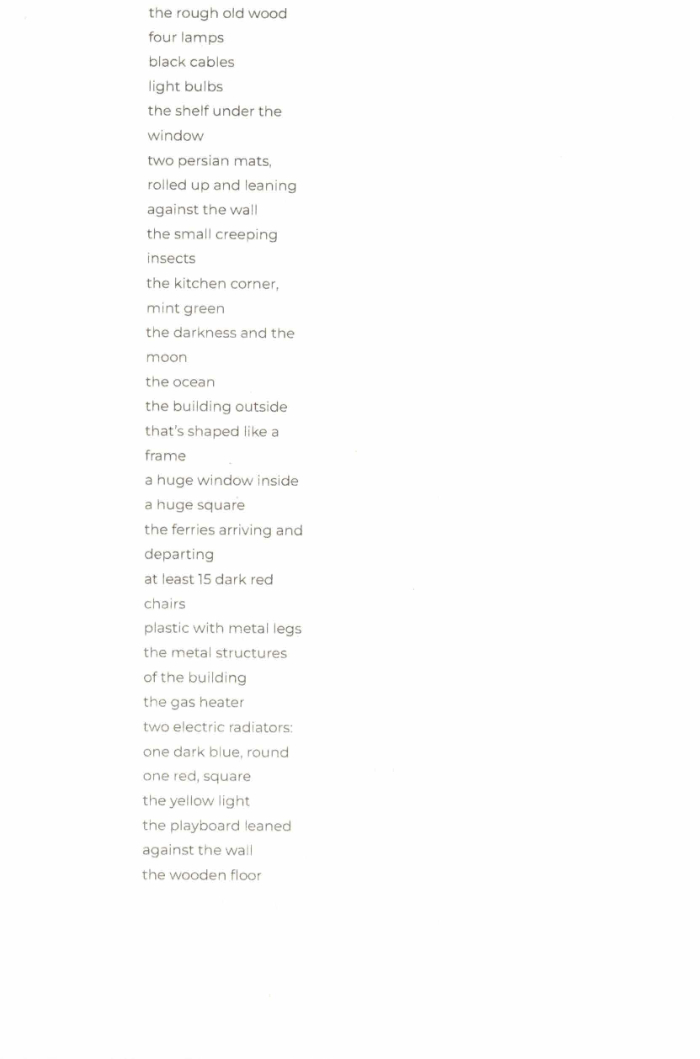
It Absorbs: On Dance as a Porous Art Object
It Absorbs: On Dance as a Porous Art Object is an essay written alongside the making of the piece dead dead document that premiered at MDT in Stockholm 2024. The essay was published in a publication that was presented together with the Reading Edge Library. The text traces contextual and material histories that the process was engaging with and questions the relationship between dance as artistic practice and place aswell as an an economy that force artists to move on.

KAMERA CAHIER N° 10
A special edition issue curated, designed and published by AVARIE, Paris and Labor Neunzehn, Berlin. It accompanies KAMERA SERIES, while it is an independent and valuable object to collect. The central idea that informs and directs the booklets’ montage is the interplay between the concepts of addition and subtraction. This is achieved by unveiling a missing image in the screening or an unreleased second from an artist's film, expanded to 24 pages. Additionally, each booklet contains a piece directly removed from the show.
The editing establishes a dialogue between film frames and performed writings derived from texts, scripts, storyboards, and notes. The KAMERA exhibition is consequently extended into a physical space—the book—allowing for its widespread dissemination, complementing and contrasting with its potential online occurrence.
KAMERA SERIES is a screening program of experimental films, video art works and printed matter taking place in a former GDR building in Berlin. Each event showcases a retrospective of selected films by an artist and a small exhibition of his/her publications or works on paper over a span of 4 days.
KAMERA centers on fostering a critical dialogue between different film formats and artists’ books. Through its regular occurrence, it aspires to create a space for community exchanges about contemporary image-making. KAMERA is a series conceived and curated by Labor Neunzehn and AVARIE.
Fascinated by the intersection of visual art and cinema, Helga Fanderl’s short poetic films evoke intense and sensitive experiences of the real world. Using a small hand-held super 8 camera, she creates filmic responses to her perceptions, weaving together imagery and emotions in dense, rhythmic patterns solely through in-camera editing. She presents silent films in the form of ‘compositions’, crafting unique programs for site-specific personal projections and transforming spaces into temporary cinemas.

KAMERA CAHIER N° 9
Peter Downsbrough (New Jersey, US, 1940) lives and works in Brussels (Belgium). Associated with major international art movements such as minimal art, conceptual art, and visual poetry, his work spans across various mediums including sculpture, wall pieces and room pieces, books, work on paper, photography, film, and video. The work, which has affinities with architecture and typography, explores the traditional use of space and language, while criticizing power structures, e.g. urbanism, that influence social interactions and shape the landscape.
A special edition issue curated, designed and published by AVARIE, Paris and Labor Neunzehn, Berlin. It accompanies KAMERA SERIES, while it is an independent and valuable object to collect.
The central idea that informs and directs the booklets’ montage is the interplay between the concepts of addition and subtraction. This is achieved by unveiling a missing image in the screening or an unreleased second from an artist's film, expanded to 24 pages. Additionally, each booklet contains a piece directly removed from the show.
The editing establishes a dialogue between film frames and performed writings derived from texts, scripts, storyboards, and notes. The KAMERA exhibition is consequently extended into a physical space—the book—allowing for its widespread dissemination, complementing and contrasting with its potential online occurrence.
KAMERA SERIES is a screening program of experimental films, video art works and printed matter taking place in a former GDR building in Berlin. Each event showcases a retrospective of selected films by an artist and a small exhibition of his/her publications or works on paper over a span of 4 days.
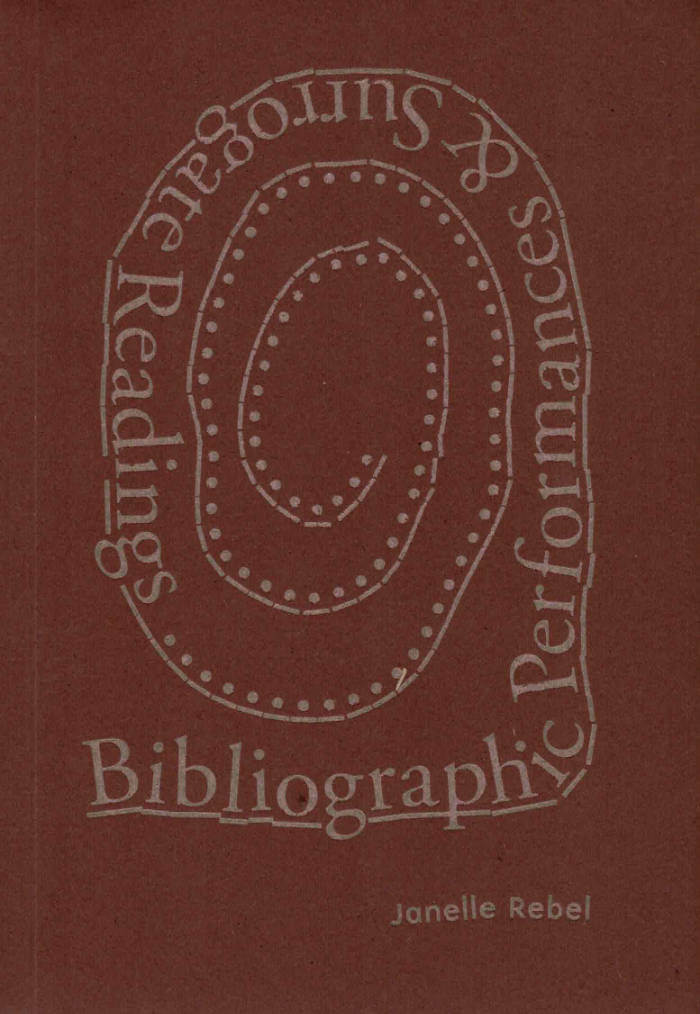
Bibliographic Performances & Surrogate Readings
Bibliographic Performances & Surrogate Readings delves into the imaginative realm of books and libraries and the interpretive structures of subject bibliographies.
It is the first monograph of its kind to historicize, theorize, and survey two decades of what the author refers to as contemporary visual bibliography or experimental subject bibliography—artistic and poetic projects that explore artifactual, intellectual, spatial, and design possibilities.
Ranging from artists’ books and web data-bases to stack interventions and reading room installations, Bibliographic Performances & Surrogate Readings reviews over fifty compelling visio-bibliographic examples created by diverse, international cultural workers.
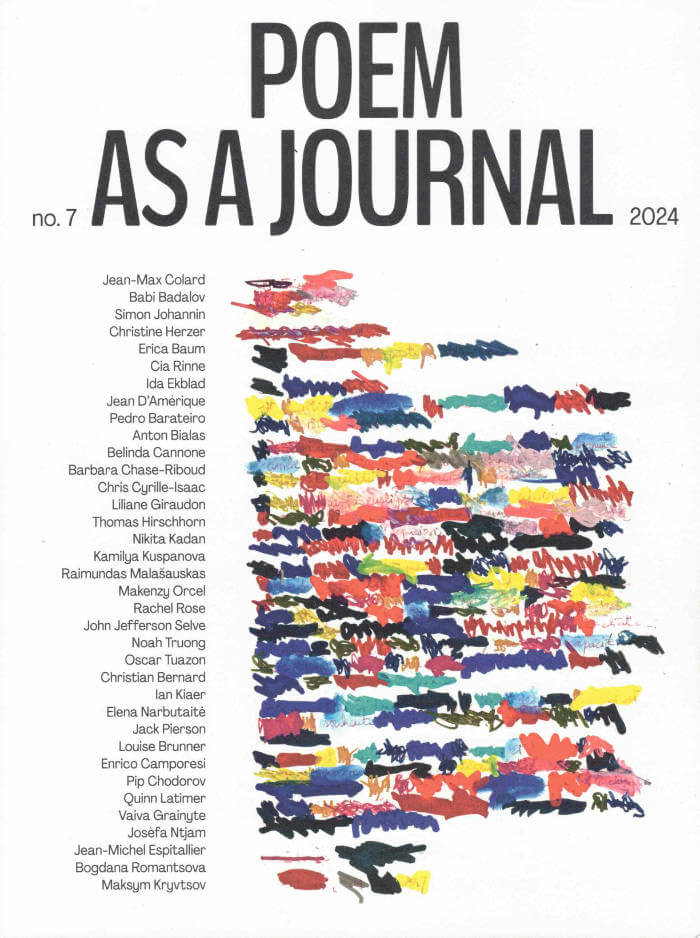
Issue 7: Poem as a Journal
What sparked off this issue of as a Journal was the clear evidence of poetry’s growing presence in the field of contemporary art. Rather than ‘Poetry’ in general, and even less so the figure of the ‘Poet’, it’s the poem that has our full attention: I find it in the title of an exhibition by Jason Dodge, on the invitation card sent out by artist Ida Ekblad, and then again in the form of an exhibition, in the display and arrangement of works within a space by Ian Kiaer, Elena Narbutaitė or Wolfgang Tillmans. Hence this open-ended question, ‘What is poetry for you today?’, placed like a probe among various art world players, in a sort of vox populi.
And so rises the confirmation of an intuition: in an art field driven by the market, where artworks are becoming luxury accessories for the jet set, poetry, with its poverty and economy of means, appears at the opposite end of the spectrum, as a pole of resistance.
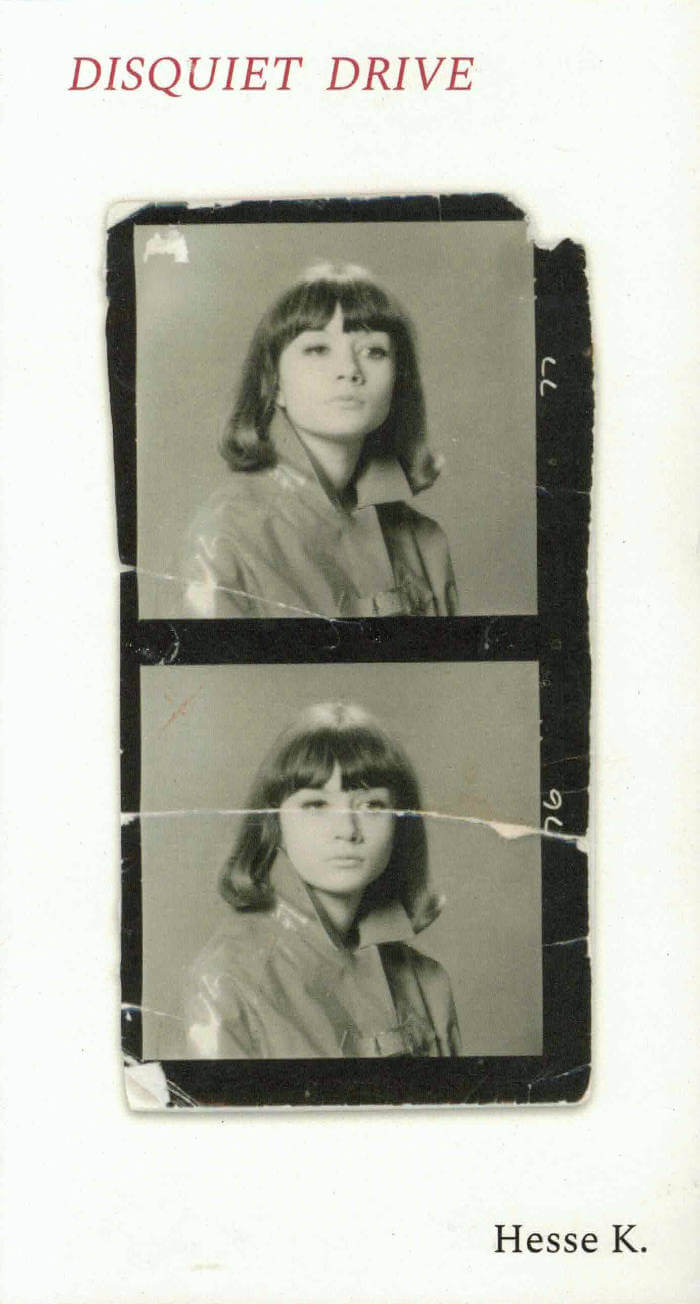
Disquiet Drive
One night a satellite falls out of the sky and splits a girl in half. Disquiet Drive is a book scraped together from the shorn parts of a person who may no longer exist. Beginning with an admission that language and embodiment seem indistinguishable, yet refusing to claim a singular voice, the texts in this collection lurch between the fiery crucible of a transition and the weird jaggedness of our own continuity; between inverted memoir and prose-poetry; the raw, irrepressible lyric and the essay as an exercise in the art of digging-one’s-heels-in. Disquiet Drive is about undoing the words we’re handed so that language can survive, and undoing the body so that it can find a way to live.
'Disquiet Drive is restlessly exquisite. Hesse K’s writing vibrates with the quiet solar intensity of a planetary body that can’t be looked at directly: things slip, slink, snick and lick into each other, limning a gorgeous periphery where genre, past and future selves, follies, fossils and hormones collide. I can’t remember when I last read something as exhilarating, beautiful and deeply attuned to the implications and contradictions involved in struggling towards a bearable world, and the ‘undomesticated sensibility’ it requires of us.' — Daisy Lafarge, author of Lovebug
'Buck wild and entirely unique, Disquiet Drive took me to the beautiful and chaotic edge of the universe and made me want to write (live) for 200 years.' — Eliot Duncan, author of Ponyboy
Hesse K. is a writer. Her criticism and poetry has appeared in MAP magazine and Montez Radio, and in anthologies by Sticky Fingers Publishing, Toothgrinder, Worms and Pilot Press, among others. She lives in London.

Salvation
Salvation is a previously-unpublished artist book by Jimmy DeSana that he conceptualized shortly before his death in 1990. The publication contains 44 of the artist’s late photographic abstractions that quietly and poetically meditate on loss, death, and nothingness. Depicted within the works are images of relics, body parts, flowers, and fruits that DeSana altered using collage and darkroom manipulations to create pictures that are both intimate and other-worldly. Salvation provides a nuanced and sophisticated counterpoint to the prevailing work around HIV/AIDS at the time, which tended to favor bold political statements.
Variations of many of the works in this book were first presented at DeSana’s last show with Pat Hearn Gallery in 1988. Shortly thereafter, the artist began assembling a maquette of Salvation, using black and white images as place holders for the color works that he intended to comprise the final layout of the publication. Sadly, he was unable to fully realize Salvation in his lifetime, but on his deathbed, he dictated instructions to his longtime friend Laurie Simmons for completing the work; instructions which she noted on each page of the single-copy maquette. With these notes, Simmons was able to match extant slides and sequencing. Simmons’ studio chose color gels from DeSana’s archive for each corresponding black and white image in the assembly of the publication. Thankfully, due to this recuperative work, Salvation—long-considered to be DeSana’s last major work—is now available for the first time, with every step taken to honor and embody DeSana’s original vision.
Jimmy DeSana (1949-1990) grew up in Atlanta, GA, and received his bachelor’s degree from the Georgia State University in 1972 before relocating to New York’s East Village in the early 1970s. Recent solo and two-person exhibitions include The Sodomite Invasion: Experimentation, Politics and Sexuality in the work of Jimmy DeSana and Marlon T. Riggs, Griffin Art Projects, Vancouver, Canada, 2020, and Remainders, Pioneer Works, Brooklyn, NY, 2016. DeSana’s work can be found in numerous public collections including the Institute of Contemporary Art, Boston, MA; Metropolitan Museum of Art, New York; Museum of Contemporary Art, Chicago, IL; Museum of Fine Arts, Houston, TX; Museum of Modern Art, New York, NY; and the Whitney Museum of American Art, New York, NY, among others. A major retrospective of DeSana’s work was exhibited at the Brooklyn Museum, New York, in 2022, accompanied by a catalogue co-published by the Brooklyn Museum and DelMonico Books.

JJ – Tartine-moi et autres textes
JJ brings together articles by cultural critic, auto/biographer, and lesbian icon Jill Johnston, translated into French for the first time, as well as texts, poems and drawings by Pauline L. Boulba, Aminata Labor, Nina Kennel and Rosanna Puyol.
Jill Johnston (1929-2010) was a dance critic, performer, writer, and feminist and lesbian activist. Her books include Marmalade Me (1971), Lesbian Nation (1973), Gullibles Travels (1974) and numerous articles in The Village Voice.
Texts by Jill Johnston; contributions by Pauline L. Boulba, Aminata Labor, Nina Kennel, Rosanna Puyol.
Translated from the English (American) by Pauline L. Boulba, Aminata Labor, Nina Kennel, Rosanna Puyol.
Graphic design: Sophie Demay & Maël Fournier-Comte (In the Shade of a Tree).

Bonbons à l'anis
Un fabuleux recueil – le premier publié en français – de poèmes et récits de l'autrice argentine Cecilia Pavón, préfacé par Chris Kraus (écrivaine dont Pavón a par ailleurs traduit des livres en espagnol).
« Cette traduction n'aurait pu voir le jour si je n'avais pas développé pendant quelques temps une obsession quasi malsaine pour l'Argentine. Cherchant à Buenos Aires les traces de lieux proches de Shanaynay que j'avais co-dirigé à Paris, je découvris au hasard sur internet l'existence d'un espace nommé Belleza y Felicidad et dirigé par Fernanda Laguna et Cecilia Pavón. Bien avant l'émergence de l'artist-run space en Europe, les deux femmes créèrent un lieu associant art et littérature. Lors d'un voyage à Buenos Aires, j'eus l'opportunité de rencontrer Cecilia Pavón qui lors d'une conversation sur l'écriture et la poésie, me proposa de traduire Licorice Candies en français. Sa poésie fut autant révélatrice qu'émancipatrice, à la fois par sa singularité et sa simplicité. Elle écrit ce qu'elle voit et ce qu'elle vit. Elle parle de certains quartiers de Buenos Aires, de ses amis, d'elle, d'un vélo qu'elle a perdu, de Timo. Il me semble qu'elle écrit comme elle parle d'amour, d'erreurs et de sexe ». Marion Vasseur Raluy, traductrice
The first collection of texts published in French by the Argentinian artist and poet.
Preface by Chris Kraus.
Translated from the English and Spanish by Marion Vasseur Raluy, Rosanna Puyol Boralevi and Mona Varichon.

Love Poems
Three long poems by American writer, artist and actor Rene Ricard (1946-2014), an icon of the New York underground in the 1970s, accompanied by a series of drawings by American painter Robert Hawkins.
After Rene Ricard 1979–1980 and God with Revolver, Editions Lutanie publishes a third collection of poetry by the American writer, artist, and actor Rene Ricard (1946–2014), Love Poems.
Reprising the rare, eponymous book published by Richard Hell through CUZ Editions in 1999, Love Poems features three poems by Ricard and a series of black-and-white drawings by Robert Hawkins). Haunted by death, betrayal, and guilt, Ricard's poems speak from a wounded heart. Hawkins's accompanying drawings have the simplicity of children's book illustrations, but feature menacing shadows, broken cigarettes, used condoms, and petal-less flowers.
Translated into French by Manon Lutanie and Rachel Valinsky, and presented in a bilingual edition, the poems are followed by a newly commissioned afterword by Hawkins retracing his encounter, friendship, and collaboration with Ricard.
With Love Poems, Editions Lutanie reaffirms its decade-long commitment—initiated the year of Ricard's passing—to reissue his out-of-print works for English-speaking readers, while also presenting them for the first time to a French-speaking audience.
"With three simple poems, Rene Ricard exposes us to the often strained love within class stratification, between those coming together from different worlds, whether Bowery panhandlers or street hustlers, Hollywood movie stars or the highest echelon of European aristocratic wealth. Rene Ricard writes poems that are always honest. Sometimes painfully so."
—Patrick Fox
Robert Hawkins (born 1951 in Sunnyvale, California) is an American artist who lives and works in London. A fabled figure of the 1980s and early 1990s East Village art and punk scene, his work is and has been collected by artists and writers including Jean-Michel Basquiat, Glenn O'Brien, and Jim Jarmusch. Among Hawkins' first exhibitions was Lower Manhattan Drawing Show, a group exhibition curated by Keith Haring at 77 White Street Gallery above the Mudd Club, in 1981.
Rene Ricard was an American writer, artist, and actor. He was born in 1946 and grew up in New Bedford, Massachusetts. After a troubled childhood, he fled to Boston as a teenager, where he came into contact with literary and artistic circles. At the age of eighteen, he moved to New York City and became a central figure in the city's artistic and literary scene. Ricard appeared in several films by Andy Warhol and continued to act in many independent films throughout his life. In the 1980s, he wrote two major collections of poetry, as well as important essays and articles, some of which were instrumental in launching the careers of artists such as Julian Schnabel and Jean-Michel Basquiat (about whom he wrote the famous article "The Radiant Child" in Artforum in 1981). Beginning in the 1990s, he developed a pictorial body of work and exhibited his paintings in various galleries in the UK and the US. He died in New York in 2014.
Edited by Manon Lutanie .
Translated from the English (American) by Manon Lutanie and Rachel Valinsky.
Drawings and afterword by Robert Hawkins.
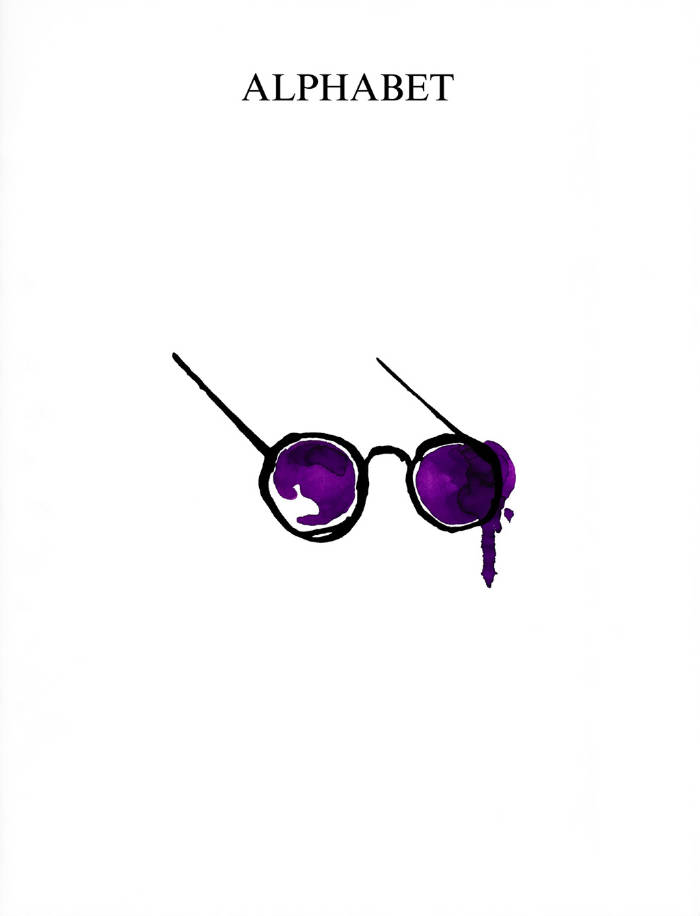
Alphabet Magazine #01
The first issue of the magazine made by artists, founded by Donatien Grau and Thomas Lenthal. Contributions by Mathias Augustyniak, Naomi Campbell, Théo Casciani, Michael Chow, Pan Daijing, Es Devlin, Claire Fontaine, Edwin Frank, Theaster Gates, Nicolas Godin, Alejandro Jodorowsky, Hedi El Kholti, Michèle Lamy, Paul McCarthy, Ian McEwan, Eileen Myles, Marc Newson, Hans Ulrich Obrist, Diana Widmaier Picasso, Ariana Reines, Barbara Chase-Riboud, Julian Schnabel & Jason Momoa, Hanna Schygulla, Juergen Teller, Iké Udé, McKenzie Wark, Robert Wilson, Yohji Yamamoto.
Alphabet is the artists' magazine. Here, they run the show. They write, they make images, they select their own works, they interview the figures they admire, they tell us what we did not know about them nor could have ever fathomed about life. This magazine is conceived entirely to put them in the driver's seat, and to enable readers to become part of the unique vision of some of today's greatest luminaries.
It is a manifestation of the creative community, coming together from all fields, from all generations and threads of culture. Writers, musicians, designers, painters, sculptors, poets—artistic figures of every kind converse all the time in their lives, but they did not have a shared space for their editorial projects. This is it.
Everyone who finds their way into Alphabet has made a mark on life, art, and culture, in a way that signals their importance to the present. Some of the contributors may be world famous, others well respected, others on the way to becoming the legends they already are. Their relevance to culture is the same, and that is why they all belong here, in the endeavor of the creative community. There is no hierarchy of status, or domain, or apparent impact. Some of the greatest revolutions happen undercover. Some of the most established voices are still breaking ground. The magazine's premise is simple: the old opposition between pop and underground does not make sense anymore. There are many creative communities, each following its own rules, each inventing its own space. Here, wherever they come from, whatever their community, artists can exist together, with the same intention of changing, and improving, what life is; with the same belief that art matters more than anything else.
None of the contributors is here randomly. They keep life thrilling and exhilarating, challenge the perception of everything and anything. Their role in shaping every aspect of life can hardly be overstated. That is why they needed a place to elaborate their own alphabet, their way of ordering and structuring language, the world, and the fabric of life—a place of freedom, where everything would be done to highlight their visions, where the very design would be a shrine to their magic. Even the distribution of the magazine was conceived with artists—each contributor suggesting sites of their liking.
Alphabet is also the magazine of magazines. Here, readers find essays, fictions, poetry, visual projects, DIY methods, recommendations from those who know, even games and astrology—and an artist's alphabet, articulating an entire universe. Anything that has ever formed a section of a magazine could find its way here. Even the cover is conceived by an artist: it was conceived especially by the legendary Robert Wilson. Artists will rejuvenate what magazines are, and magazines will be kept forever young by and with them.
Founded by Donatien Grau and Thomas Lenthal, Alphabet is a bi-yearly art magazine. Not a magazine about art. It's a magazine made by artists. Each contribution like an œuvre, making it the ultimate collector piece. Each cover is designed, with the word Alphabet, by a different artist, initiating a cult series.

Myth Lab: Theories of Plastic Love
Myth Lab: Theories of Plastic Love is a genre-defiant sex-trip to post-human dimensions. If C.G Jung, magic-mushroom shaman Terence McKenna and Camille Paglia (Sexual Personae) had a three-way while binging on George Bataille and undergoing Hormone Replacement Therapy, their baby might be the erotic cocktail of Myth Lab. Its extreme theme is nothing less than the fate of the species.
“Brilliant and wild, Jack Skelley’s Myth Lab is a manifesto of exuberance disguised as a sci-fi sex test-center for the invention of communal futures. Skelley’s a mad scientist, scholar and poet.” - Chris Kraus, author of After Kathy Acker
“In Myth Lab, Jack Skelley adroitly molds an “Einsteinian elasticity between objects and ether” to the “clitoverse.” If this formulation seems too vast, just think about a) the last time you felt good about power and b) all the ways to say yes to pleasure as a source of liberation. In conducting a “cosmologic psychoanalysis,” Myth Lab thrillingly hot wires our neurons to an endless mirror stage reflective of our own instinctual nature.” - Kim Rosenfield, author of Phantom Captain
"An explosion of clit-cock-and-pop-culture worship. Skelley’s eroto-celestial universe fights back not only against the denial of desire – “also known as fuckheadocracy and market forces” – but against death itself." - Francesca Lia Block, author of Weetzie Bat
"A hallucinatory book that straddles gender studies, science-fiction, and cultural criticism (to name but three of many genres). Ever eager to use a newfound Skelley-ism, I urge everyone to read Myth Lab and be “Kardashian'd” with love (i.e buy it now, it's great)." - Susan Finlay, author of The Jacques Lacan Foundation
"In Jack Skelley’s Myth Lab, something weird and beautiful is forged in the crucible of infinite horny grief. It’s an epic, delirious descent into the inferno, navigating the concentric circles of romance and desire as literary malady, TikTok psyop, benevolent cosmological principle, and more. Simultaneously a quest, a physics experiment and an elegy. I loved following its narrator - a tender, erotomanic, Blakean particle - seeking and finding visionary head." - Daisy Lafarge, author of Love Bug

Wave of Blood
Is it the computerization of the planet
Or a loosening of my fidelity to suffering
I don’t understand the intensity
I’ve hidden here but I know I despaired
Of finding a physical place to keep
My tears. Now what. Seas that go turquoise
When you stop looking at them . . .
Wrestling with the mind of war, at times shocking in its self-analysis, Wave of Blood is a furious and sincere essay, an eclipse notebook, a family chronicle, all told in the poetry of witness.
Praise for Ariana Reines:
Ariana Reines is a go-for-broke artist who honors her traditions by being like no one else. Some of us have made a fetish of our stupidity, pretending to forget history, and some of us have made a fetish of despair, congratulating ourselves on melancholia, but Ariana is too brilliant and too alive for either of those sad luxuries... I am convinced of the authenticity of the summonses she receives and the summonses she issues and when I read her I am reminded that all of this is a calling before it's an identity or career. Her voice-which is always more than hers alone is a dialectic between the very ancient and the bleeding edge. - Ben Lerner
Reines's books are works of intellectual commitment and structural sophistication; at the same time, they allow the raw stuff of being, in all its messiness, to enter the page. -The White Review
Mind-blowing. - Kim Gordon
Her writing is queer and raunchy, raw and occult, seemingly never pulling away from her deepest vulnerabilities. Yet Reines simultaneously maintains a feeling of epic poetry, of ancient intention. She moves between worlds in search of the divine and the self. - The New York Times
These are the kinds of poems that reorient you in the world, make you understand how little you know, but how much is inside you. - NYLON

How to Leave the World
Everyone is asking about his identity. Gay? Muslim? French? Moroccan? Instead of choosing a side, he writes a book. A book about the forest and the city, Paris and Tangiers, shame and forgiveness, dating apps and spiritual discovery. A book about growing up as a diaspora kid in rural France, with desires that want to emerge at any cost. Told in mesmerising prose, How to Leave the World is a beautiful non-answer.
A rare book that depicts the isolation and poetry of rural life. — Annie Ernaux
What it takes to imagine social and physical freedom is what it meant to keep reading this incredible book. — Bhanu Kapil
Marouane Bakhti is a writer and arts journalist. Born in Nantes, France to a Moroccan father and a French mother, he studied history and journalism at the Sorbonne. He writes criticism for Mouvement magazine and lives in Paris. How to Leave the World is his first novel.
Lara Vergnaud is a literary translator of French and has translated over a dozen novels, including works by Zahia Rahmani, Fatima Daas, Mohamed Leftah and Mohamed Mbougar Sarr. Lara was born in Tunisia, grew up in the United States and currently lives in southern France.
978-1-7395161-3-0
21.6 x 13.9 cm
112 pp, paperback
September 2024

Black Meme
A history of Black imagery that recasts our understanding of visual culture and technology
In Black Meme, Legacy Russell, awardwinning author of the groundbreaking Glitch Feminism, explores the “meme” as mapped to Black visual culture from 1900 to the present, mining both archival and contemporary media.
Russell argues that without the contributions of Black people, digital culture would not exist in its current form. These meditations include the circulation of lynching postcards; why a mother allowed JET magazine to publish a picture of her dead son, Emmett Till; and how the televised broadcast of protesters in Selma changed the debate on civil rights. Questions of the media representation of Blackness come to the fore as Russell considers how citizen-recorded footage of the LAPD beating Rodney King became the first viral video. Why the Anita Hill hearings shed light on the media’s creation of the Black icon. The ownership of Black imagery and death is considered in the story of Tamara Lanier’s fight to reclaim the daguerreotypes of her enslaved ancestors from Harvard. Meanwhile the live broadcast on Facebook of the murder of Philando Castile by the police after he was stopped for a broken taillight forces us to bear witness to the persistent legacy of the Black meme.
Through imagery, memory, and technology, Black Meme shows us how images of Blackness have always been central to our understanding of the modern world.

Gaza or Palestin* or "West Bank" or (...)
Anita Di Bianco’s ongoing project, Corrections and Clarifications, is a newspaper without headlines, a cyclical reverse-chronology of daily revisions, retractions, re-wordings, distinctions and apologies to print and online news, printed in numerous languages, locations, and formats since September 2001. An intermittent catalog of lapses in naming and classification, of tangled catchphrases, obstinate patterns of mis-speech and inflection, connotation and enumeration. The twentieth anniversary hardbound edition of the publication, entitled The Error is Regretted, was published in 2021 by The Green Box in Berlin.
This 2024 iteration, in a xeroxed edition of 100, collects corrections to news items back to 1981 — with its focus on the Eastern Mediterranean region, on patterns of mis-telling and misrepresentation through the persistent misuse of the passive voice, the omission of widely observable and verifiable facts and events, the euphemizing and toning down of deliberate actions, erasures through shifts in terminologies, through bold mistakes and tentative corrections.
Anita Di Bianco’s works in film, video, and print take up, modify and re-work existing and re-imagined patterns and characterization. Her work involves the imitative act, a taste for the possession and expulsion of narratives, the appropriation and accumulation of familiar texts and writing styles. Anita uses widely varying sources: from theatrical and historical texts to oft-quoted cinematic clips and thematic references. She lives in Frankfurt am Main.

How Are Artists Chosen? Exclusivity, precarious work and asymmetries in Art Competitions
Ramaya Tegegne, Tiphanie Blanc
The third volume of a new series of publications by the collective Wages For Wages Against, acting for better work conditions in the visual arts and against all forms of discrimination.
In 2022, the collective Wages for Wages Against applied for the Swiss Art Awards with the ambition of questioning the very model of the prize and its impact on artists. Art competitions are presented as real opportunities for artists, and arise throughout their careers, starting with school—entrance selection procedure, juried evaluations, diplomas and honors distinctions—, all the way to professional recognition—Meret Oppenheim Prize, Marcel Duchamp Prize, Turner Prize, etc. Only a handful of artists are selected for merit-based reward. However, this logic of sorting and validation upholds an entire system that reproduces inequalities and that perpetuates precarity in a milieu that is exclusive, and thus excludes. The institutional practices of communication and selection, as well as the validation of unpaid labor, favor certain artists at the expense of others. In this context, we surveyed the artists who participated, are considering participating, or are not participating in the Swiss Art Awards competition, in the interest of understanding their experiences and sharing their demands. In a broader sense, we wish to rethink the founding principles of artists' support policies and work to build a less competitive art world.
Wages For Wages Against (WFWA, wfwa.ch) is a a militant collective and a campaign for the fair remuneration of artists in Switzerland, better work conditions, and an alternative economy of the arts.
Contributions by Nathalie Stirnimann & Stefan Stojanovic and Amandine Gay.

Imperfect Solidarities
Art, empathy and political solidarity.
Can empathy deliver political change? Does art that elicits emotional identification with others take us where we need to go? In Imperfect Solidarities, writer and art historian Aruna D'Souza offers observations pulled from current events as well as contemporary art that suggest that a feeling of understanding or closeness based on emotion is an imperfect ground for solidarity. Empathy—and its correlate, love—is a distraction from the hard work that needs to be done to achieve justice. Rather, D'Souza contends, we need to imagine a form of political solidarity that is not based on empathy, but on the much more difficult obligation of care. When we can respect the unknowability of the other and still care for and with them, without translating ourselves into their terms, perhaps we will fare better at building political bridges.
Aruna D'Souza is a writer and critic based in New York. She is a regular contributor to The New York Times and 4Columns.org, where she is a member of the editorial advisory board. Her writing has also appeared in The Wall Street Journal, CNN.com, Bookforum, Frieze, Momus, and Art in America, among other places. Her book, Whitewalling: Art, Race, and Protest in 3 Acts (Badlands Unlimited), was named one of the best art books of 2018 by The New York Times. She is the recipient of the 2021 Rabkin Prize for art journalism and a 2019 Andy Warhol Foundation Art Writers Grant.
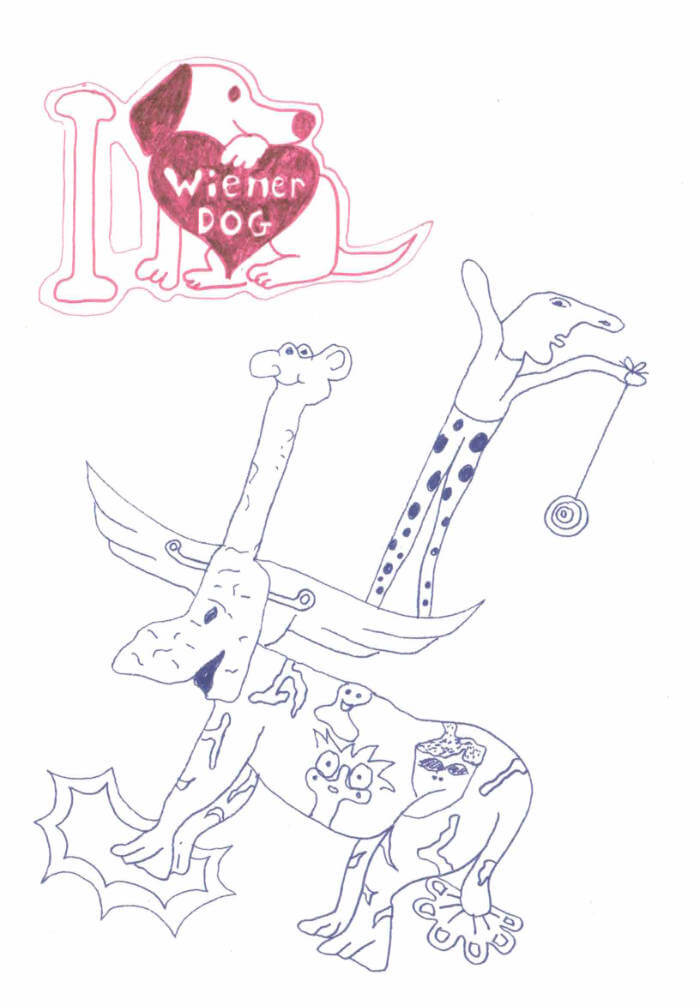
I Love Wiener Dog
A series of “Bad Paintings” by the Geneva-based artist.
White noise escapes from the 3rd floor of an opulent building located in the Eaux-Vives district. In an apartment, converted into a laboratory, hum a whole bunch of complicated machines linked together by a tangle of multicolored electrical wires. In the middle of all this mess, wrapped in transparent plastic sheets, a new experience will take place in a few moments.
Indeed, for the first time in history, a team of researchers will be able to precisely decode the creative process of an artist. Plunged into an artificial coma, the Genevan painter Josse Bailly wears a sort of motorcycle helmet, from which colorful cables spring. At the end of the test, Bailly's abundant pictorial practice will no longer have any secrets for the scientists present. The mechanism of his artistic frenzy, this true fury to paint, will be translated in an intelligible and logical manner.
Suddenly, a crackling sound is heard. Eyes rolling back, Bailly suddenly sits up square on the massage table transformed into an electric chair. Foaming at the mouth, he chants a series of names of old rock groups from the 70s. Sparks come out of the artist's blackened nostrils. His head looks like it's going to explode any minute. The screens light up in the smoke. Words scroll continuously on the monitors: "The beanbag chair", "Harvard beets", "I love wiener dog".
The pellets go off, putting an end to the strange scene which is more reminiscent of a planned execution than a scientific study. An expression of perplexity freezes on the stunned faces of the team of researchers. In a heavy silence where there is a smell of scorching, a young assistant risks slipping in a confused voice: "I think he likes to illustrate wiener dogs because he finds them cute and it's cool to draw them."

The Significance and Relevance of Early Modern Indian Painters to the Contemporary Indian Art
The Significance and Relevance of Early Modern Indian Painters to the Contemporary Indian Art, written in 1971, reevaluates the legacies of painting inherited by the artist Nilima Sheikh.
Drifting between two inadequate models, one an import of British Colonialism, and another desperate for an identification as "Indian", the artist engages with the works of Raja Ravi Varma, Abanindranath Tagore, Amrita Sher-Gil, Nandalal Bose, and Jamini Roy, as well as the critical and art historical writing surrounding these practices, to offer a revaluation of these legacies and a possible way forward—one that she would go on to articulate in her own decades-long engagement with painting.
Published here for the first time, The Significance and Relevance of Early Modern Indian Painters to the Contemporary Indian Art was written as part of Nilima Sheikh's Master's in Painting at the Faculty of Fine Arts, Maharaja Sayajirao University of Baroda. The complete facsimile of this dissertation is accompanied by a recent interview with the artist by Nihaal Faizal and Sarasija Subramanian.